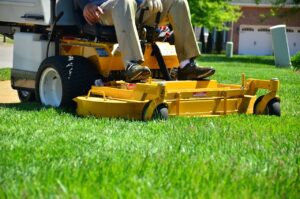Creating a solid online presence for your lawn care and landscaping business involves more than just throwing together a five-page website and hoping for the best. To truly make an impact and attract potential clients, it’s essential to invest in search engine optimization (SEO).
The good news is that SEO for lawn care and landscaping websites can be simple. You don’t need to be a tech wizard to implement effective strategies. SEO boils down to sending the right signals to search engines and your target audience.
To demystify the process, here are seven straightforward practices that you can accomplish within the next three to six months to optimize various aspects of your website.
Improving Domain Age
Initiating with a fundamental task, the age of your domain holds significant weight in bolstering your website’s credibility. Search engines not only delve into your historical performance but also factor in your future trajectory.
If you are the current owner of a domain, take a moment to navigate to whois.com and scrutinize your domain’s expiration date. Should it be set to expire within the next 12 months, consider renewing it for a duration spanning at least two years. This advice extends to new domains as well. Opting for multi-year registrations not only fortifies your website’s legitimacy but also signals to search engines your commitment to a lasting online presence.
Finding Local Keywords
In the Bullseye article featured in the October edition of Lawn & Landscape Magazine, we delved into the importance of creating buyer personas. Interestingly, this practice isn’t limited to just understanding your audience but can also be applied when determining keywords for your business.
Begin the process of identifying the best keywords for your business by first defining your target service area. Pinpoint where your potential customers are located—whether it’s a specific city, state, county, neighborhood, or even a distinct geographical area like a “panhandle,” as seen in the Florida panhandle.
The second crucial step involves determining the specificity required in defining your service offerings. Understand the problems your clients are looking to solve. Are they seeking general landscape services, or is their need more specialized, such as grading or irrigation installation?
There are various tools at your disposal to discover the most appropriate keywords for your business. Consider utilizing paid services like Hubspot, an inbound marketing software, or opt for free alternatives like Google Keyword Planner or other user-friendly keyword tools available. By following these steps, you can refine your keyword strategy and enhance the visibility of your business online.
Optimized Title Tags
Title tags are part of your website metadata, which acts as a more descriptive and formatted version of URLs on your website. Each page on your website should have a unique title tag, which is at most 55 characters long.
To explain this further, take a look at the website URL for HighGrove Partners in Atlanta, Georgia (disclosure: HighGrove is a client of Landscape Leadership): HighGrove’s current home page URL: www.highgrove.net.HighGrove’s current home page title tag: HighGrove Partners | Commercial Landscaping Atlanta Austell GA. As illustrated in the image below, the company uses unique title tags on each of its pages to replace its non-descript URLs with local keywords and services. These flow more naturally, like short sentences describing the services referred to on each specific page.

Engaging Meta Descriptions
Similar to your page title tags, meta descriptions are created in your website metadata, which means they are not visible on your website, Only in search engine results. It consists of 150 characters; these descriptions should contain one or two compelling sentences describing your specific company services and local service area to give your potential clients a preview of the contents of your webpage.
Each page of your website should contain a unique meta description that focuses on improving your click-through conversions, not just your rankings.
For example, conduct a search on any business in your area. Scan the search results and compare the optimized and un-optimized meta descriptions below the web page titles. Which websites were more effective in convincing you to click through?
Dual-Purpose Images
No matter the nature of your lawn care or landscape service, the primary focus lies in the visual impact of your work. Consequently, a significant portion of your website will highlight photographic representations of your services. To optimize these images effectively, consider updating or adding three fundamental values:
- File Name: Eliminate generic attributes and numerical identifiers from your file names. Instead, incorporate specific details such as location and services offered to enhance search relevance.
- Image Title: Enhance your image titles by including your company name, precise location, and the specific services showcased, mirroring the structure of your page titles.
- Image Alt-text: Craft concise meta descriptions for your images, providing an additional layer of information that aids in search engine optimization and offers a brief yet informative description of each image.
By diligently formatting your images in this manner, you can leverage their potential to not only attract prospective clients to your website but also play a pivotal role in closing deals by effectively showcasing the tangible results of your services.
Google+ Local
Google’s local business directory, formerly known as Google Places and now Google+ Local, stands out as one of the most comprehensive online platforms for business citations. Creating a listing on Google+ Local offers numerous benefits for new lawn care and landscape companies, ranging from heightened visibility in local search results to providing detailed directions through Google Maps, showcasing branded images, and highlighting client reviews.
When ready to promote your lawn care or landscape business, initiating a listing on Google+ Local is crucial. To get started:
- Visit the Google+ Local website and set up an account.
- Once your account is active, proceed to the listing page, where you can input essential information such as your company’s Name, Address, and Phone number (NAP).
- Pay attention to other crucial details like your tagline, company description, and operating hours.
To optimize your listing, carefully select the appropriate business category. Ensure accurate categorization, choosing the most specific option available, such as Landscape Designer or Commercial Landscape Maintenance. A thorough and complete listing, including these details, proves more effective than a basic one.
As illustrated in the accompanying image, observe how HighGrove Partners has maximized its Google+ Local page by incorporating its logo and branding. This visual element adds a professional touch to the listing, enhancing the overall presentation of the business on the platform.
Consistency in all citations
Since the recent implementation of Google’s Penguin update, specific citations now hold sway over search rankings. These citations refer to business listings on various local directories like Bing Business Portal, Foursquare, Manta, Yellowpages, Yelp, WhitePages, and YahooLocal.
Google meticulously crawls each of these platforms, cross-referencing the NAP (Name, Address, Phone number) information you’ve provided with other citation listings. It can enhance your website’s credibility and search rankings; it’s crucial to ensure consistent and exact matches across all these platforms.
Google penalizes mismatched information, underscoring the importance of maintaining uniformity in your business details across directories. To assist in evaluating your current listings, you can utilize Landscape Leadership’s complimentary website scanning tool, the Citation Listing Scanning Tool.
It’s advisable to list your company in a select few directories, prioritizing quality over quantity. This strategic approach helps to save time and resources. For your convenience, we’ve assembled a downloadable list featuring the top 20 citations in our Local Business Directories Worksheet.
Start right now
The timeline for implementing these enhancements varies depending on your familiarity with website design and the scale of your existing site. Utilizing this SEO checklist for landscaping websites, you can distribute these improvements across a week or extend them over the coming month.
Several of these adjustments are one-time tasks, offering a lasting impact. Once properly executed, elements such as title tags, images, and meta descriptions may require minimal updates.
While the effects may not be immediately noticeable, these seven quick fixes serve as foundational steps within a broader SEO strategy. Particularly beneficial for those striving to establish a prominent presence in local search results, these fundamental practices enhance your rankings and establish credibility for your website.
However, for sustained success, it’s imperative to contemplate a more holistic inbound strategy to uphold your position over time.
Author
